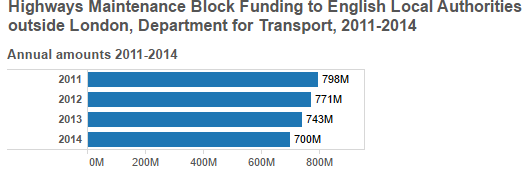Teresa Jolley reflects on the key messages from the South West engagement session held by the Department for Transport in Exeter on 3rd March 2014 to consult on proposed funding changes for Highways Maintenance block capital funding post 2015.
The Department for Transport is proposing greater certainty of funding for Highways Maintenance between 2015/16-2020/21, which is good news for local highways authorities struggling to keep on top of the deteriorating state of our local road network.
Whilst clarity and certainty of funding over a 6-year period is a welcome step-change, working out whether / how to incentivise local authorities and evidence how money is spent are causing some headaches.
From the Department for Transport’s perspective providing 6 year forecasts, increasing the amount of money available, and removing restrictions on its use also means some relinquishing control over how that money is spent and accounted for. After years controlling an annual funding pot for local authority highways maintenance, this is understandably a little scary.
From the Local Authority perspective, greater visibility of future funding and more flexibility in how it can be spent makes it easier to plan in the longer term to address specific local issues. The fewer the number of funding sources, particularly those for project-specific bids where time and effort to submit schemes is also needed, the better. This frees up resources to do the work on the ground, rather than administration.
Since the abolition of national performance indicators requested by central government (which were responded to largely as a tick-box exercise by local authorities), both parties are trying to work out how best to evidence value for money.
For example, the CQC for Maintenance trial project is exploring which performance indicators can be used to evidence and relate together Public Satisfaction (Customers), Quality and Cost.
But overall, progress in this area is slow, and we’ve so far failed to create the step-change needed away from the focus on outputs and league tables following the Constructing Excellence Key Performance Indicators, and the publication of the Constructing the Team by Latham (1994), Rethinking Construction by Egan (1998), and Never Waste a Good Crisis, by Wolstenholme (2009).
Rather than trying to find ways to add a layer of ‘performance management’ onto daily activities, couldn’t we find and present evidence from the data used to do the work itself? The CIPFA Code of Practice on Transport Infrastructure Assets is a good building block in this direction, but it is still only guidance, and with no national co-ordinated management of the collected data, it’s value is currently limited.
The greater foresight we can give local authorities for funding, the greater the opportunity they have to plan their highways maintenance activities. Without this, it is not possible to do justice to the production of Highways Asset Management Plans. Several authorities have not yet created these plans, of those that have, many are ‘sat on the shelf gathering dust’. Instead of reprimanding authorities, or introducing ‘incentive’ payments to encourage the creation of these Plans, we should be using the Highways Maintenance Efficiency Programme to help deliver the tools needed to make these plans valuable and actionable.
With the right tools, the process of creating the Highways Asset Management Plan will help local authorities:
- Plan the work with technical teams: prioritise and plan the maintenance work needed to bring the roads back to (and maintain) a good condition;
- Check longer term plans and identify relevant funding for future years: foresight of future big maintenance works, making it easier to secure funding for these works in advance.
- Engage with councillors and the public on our plans for managing local roads: once they understand their authorities plans they become very willing supporters, or at least less critical because they know what we’re doing.
